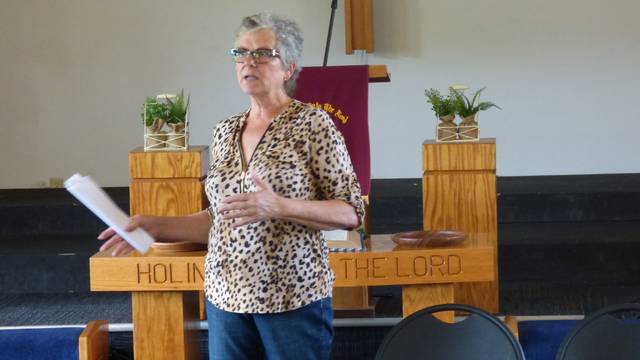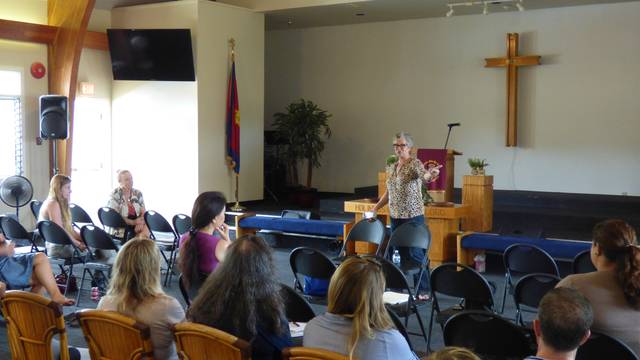KAILUA-KONA — Hawaii County’s share of the Transient Accommodations Tax, which Mayor Harry Kim has lamented repeatedly as a primary cause for coming tax hikes to balance this year’s budget, continues to be a topic of conversation, and some contention, on the Big Island.
It surfaced again at a Hui Laulima Council meeting at the Salvation Army in Kailua-Kona Friday morning where Rep. Cindy Evans — who represents North Kona, North Kohala and South Kohala — was the guest speaker.
The state decreased the share of the TAT meant for the counties from $103 million annually to $93 million in the wake of the Great Recession of 2008 to help balance the state budget.
That reduction removed $1.7 million from Hawaii County coffers. Evans said, however, that’s a drop in the bucket when viewed side by side with the $491.2 million county budget for next fiscal year, rejecting the mayor’s assertion that it plays a significant role as a catalyst for tax hikes.
“What really caused the property tax to go up — and they don’t say it, and I don’t know why — is the collective bargaining,” Evans said. “We raised everybody’s salaries a lot this year and that passed through to the county.”
Rising salaries elevate fixed costs the county pays in perpetuity and also increase pensions. A new system is now in place for incoming employees, but pensions of those already in the system aren’t determined precisely by salaries. Instead, they’re based on wages earned over an employee’s final three years on the job.
That means overtime pay is factored into pension amounts, which drives up the county’s fixed costs even further. It’s a stipulation Evans said she’s tried to fight to no avail.
Whether to place responsibility on the county or the state for this increasing burden, which was exacerbated by 4 percent salary hike statewide in the most recent round of collective bargaining, isn’t simple to pin down.
Salary increases are based on a vote, Kim said, with one vote belonging to each county and four votes at the state level that swing with whatever Gov. David Ige wants. All it took was one county to vote with the governor for the raises to pass, and that vote didn’t come from Kim.
“I stated to all the mayors, I stated to the governor, the unions all knew it …. that this administration would not support any raise,” Kim said at a Rotary Club meeting in Kona last month.
But the system is what the system is, Evans explained Friday.
“We can always go in and try different models, but this is a very unusual state,” she said. “You don’t have states that just have four counties and that’s it.”
Because of Hawaii’s unique governmental structure, the state shoulders the burden for public education, public hospitals, the courts and the correctional facilities across all counties. The general consensus throughout the Legislature, Evans said, is that such a system justifies the state capping TAT disbursement to the counties.
“I believe, like a lot of my neighbor island legislators, that we need to push that TAT back up some, but we also need to recognize and get an acknowledgement that the state is picking up some of the county functions,” she said.
There was talk last session of upping the TAT, which was set at 5 percent when it was initially established. It has nearly doubled to 9.75 percent in subsequent years. Those discussions centered around increasing the rate by 2.75 percent to 12.5 percent but were met with resistance from the tourism industry.
The industry’s protests center around the argument that it’s already expensive to travel to Hawaii and if room rates are increased, many Americans may decide to travel to cheaper destinations on the mainland.
Evans said the tipping point at which tourism numbers would be impacted is yet unknown, but added tourism interests were open to a potential raise of 1 percent after a 2.75 percent hike was proposed.
Still, that wouldn’t benefit Hawaii County financially, she explained. Any increase would go to HART on Oahu, dedicated to funding the island’s increasingly expensive rail project.
“There was no discussion of it ever going to counties to help raise the (TAT) cap,” Evans said.
Kirstin Kahaloa, former executive director of the Kona-Kohala Chamber of Commerce, attended the meeting Friday and offered thoughts from a county perspective.
“We’re seeing all this growth and excitement, and it’s going to create a boom in our economy and create all these jobs and opportunities,” said Kahaloa, referencing the return of direct flights to Kona on Japan Airlines as one example. “But it’s also going to be at the cost to roads, to emergency response, to a lot of services the county directly supports.
“If a tourist is paying into the TAT, some of it should go back into the services to revitalize the tourism industry,” she continued.
“We need to take care of assets like roads and the airport. If the state isn’t putting money back into that, we’re going to have people not wanting to come here because it’s not up to the standards of other communities they visit.”






